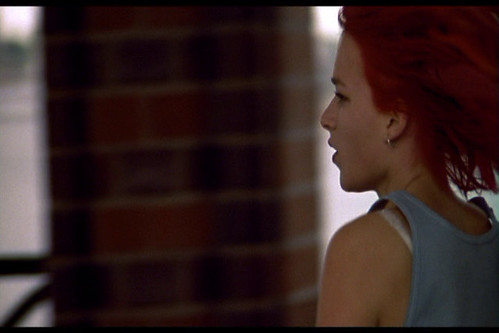This post is part of a project to watch the Film Bloggers’ 100 Favorite Non-English Films. See my progress here.

Run Lola Run (Lola Rennt)
Germany 1998; dir: Tom Tykwer
starring: Franka Potente, Moritz Bliebtreu
screened 1/28/08, DVD
“I wish I was a heartbeat that never comes to rest.”
Previous Viewing Experience: Oh, golly. This will be the fifth time I’ve seen this film. Guess you know I like it, eh? (Although I’ve seen Citizen Kane as many times, and I don’t particularly like it…)
Knowledge Before Viewing: This is one of my all-time favorite films, but I haven’t really written anything about it. So it’ll be interesting to see it with the intention of writing about it. The response will still likely be “OMG, I love this movie so much!!!!11!” Oh well. I honestly can’t remember what I’d heard about it before watching it the first time, or what my expectations were. But I’m sure they were exceeded.
Previous Reactions: I’ve never reviewed it before, but my rating on it is “Superior,” no question. It’s number 3 on my Best Films of 1999 list (it opened in the US in 1999, though it released in Germany in ’98), and 1999 was a VERY good year for movies. Run Lola Run is one of two foreign films I use to bait people who say they don’t like foreign films (the other is Amelie, at #92 on this list). So far I’ve never shown it to anyone who didn’t love it; it taps into the MTV generation’s love of quick editing and techno-rock music (one of the best soundtracks to drive to, by the way), but also manages a surprising amount of depth in both story and narrative technique. I’m just glad to have an excuse to watch it again. :)
Brief Synopsis: Lola’s boyfriend Manni has lost a bag containing 100,000 marks which belongs to a local crime lord; she has twenty minutes to somehow get enough money to bail him out of the situation. Her attempt to get the money is repeated three times, with slight variations.
Response: Have I mentioned that I love this movie? Yeah, still do. On a philosophic level, it’s a fascinating inquiry into the nature of time, the efficacy of human action, and the mutability of fate. Each time through, there are slight differences: the first time, Lola might nearly run into a woman with a baby stroller, the second time, she does run into her. We’re shown in a rapid series of stills what happens to the woman afterwards: the first time, she loses her child to child services and steals another, the second she wins the lottery. There are several of these “and then” sequences for various people Lola encounters, and each one shows a different outcome. It’s tempting to imagine a cause-effect relation between Lola’s encounters with them and their futures, but I’m not sure that’s right; these are coincidental moments of little or no consequence–it could be a case of the butterfly effect (small actions have large consequences and the slight changes lead to radically different ends), but I think it’s simply that each person has a multitude of possible futures, and the film doesn’t necessarily comment on the degree of interrelation between chance and human action. It’s definitely a postmodern film, and the idea of multiple branching futures is found in a lot of postmodern narratives–compare it to certain sections of Italo Calvino’s Invisible Cities and If on a winter’s night a traveler, for example, or Jorge Luis Borges’s Labyrinths.
[This video is of the third time through the sequence]
The idea of multiple futures is backed up obviously by the tripartite structure, in which the first two attempts to save Manni fail, and Lola decides to try again–and does! The opening sequence, before we meet Manni and Lola, suggests that we’re playing a game which, like football (er, soccer), has established rules–the ball is round, the game lasts ninety minutes. Those are the constraints we’re given in the world we’re about to enter. But Lola doesn’t play by the established rules. And neither does this film, in all the best ways. Stylistically, Tykwer pulls every trick he can find: There are animated segments (which are just cool anyway, but also highlight the constructedness and artificiality of the story we’re watching), black and white sections, nearly frame-by-frame montages, long tracking shots, interspersed stills, jump cuts, handheld shots, split-screen (eat your heart out, 24), you name it. You’d think with all that he wouldn’t have time for much else, but there’s an entire subplot about Lola’s father and his mistress which surprises me every time with its depth, despite its sum total of probably four minutes on screen.
And there’s so much more I could probably talk about, but those are the main things that impress me every time. It’s just so enjoyable to watch, so well-structured as a narrative, and so fascinating as a philosophical exercise–and there are so few movies that manage to be all three, and in less than 90 minutes, too.
(Since I’ve seen this many times before, I opted not to include two responses; the response above can be considered a reflective response as well as an immediately-after-viewing response.)
Picspam!: Haven’t been able to do this on the last several, because I can’t screencap videos. Yay for DVDs! And movies I want to take the time to screencap.

Leave a Reply